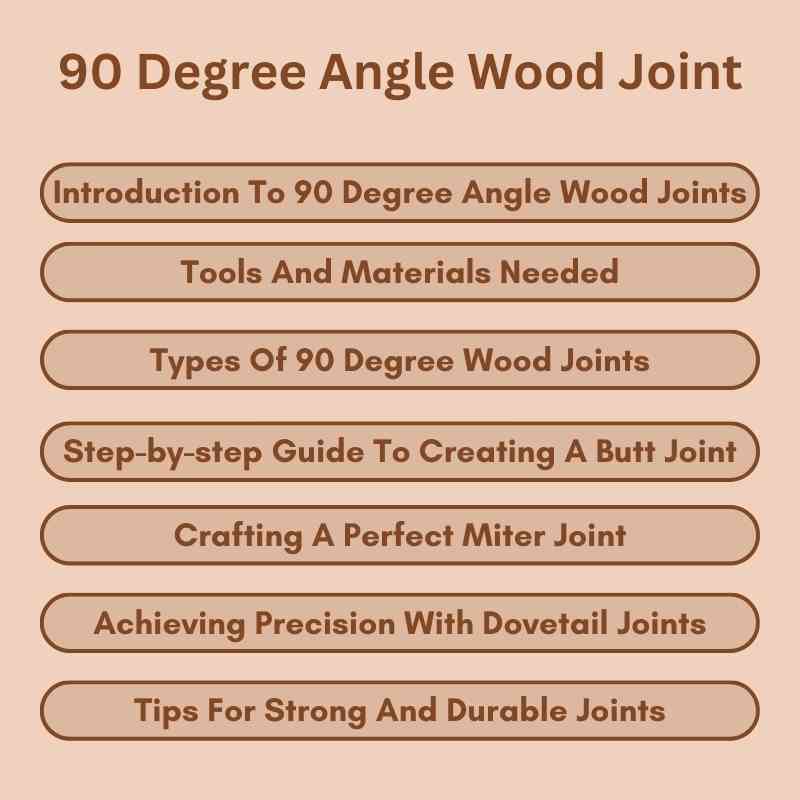A 90-degree angle wood joint, also known as a right angle joint, connects two pieces of wood at a perpendicular angle. This joint is essential in woodworking projects for creating strong, square corners.
A 90-degree angle wood joint is fundamental in carpentry and woodworking. It connects two pieces of wood at a right angle, ensuring stability and precision in structures like frames, boxes, and furniture. These joints are crucial for maintaining the integrity and alignment of the construction.
Common types include butt joints, miter joints, and dovetail joints, each offering different levels of strength and aesthetic appeal. Properly executed, these joints can significantly enhance the durability and appearance of a woodworking project, making them a staple technique for both amateur and professional woodworkers.
Introduction To 90 Degree Angle Wood Joints
90 degree angle wood joints are very strong. They are essential in woodworking projects. These joints help make furniture and frames. They hold pieces of wood together firmly. Without these joints, wood structures would be weak. Many woodworkers use them because they are reliable. These joints also make the structure look neat.
These joints are used in making tables. They are also used in chairs and cabinets. You can see them in picture frames. Shelves use these joints for stability. Boxes and drawers also use 90 degree joints. These joints help in making doors and windows. Many wood items in your home have these joints.

Tools And Materials Needed
A saw is needed to cut the wood. A measuring tape helps ensure accuracy. Clamps hold pieces together while working. Screws and a screwdriver are required for assembly. Sandpaper smooths the wood surface.
Use hardwood for a strong joint. Plywood is another good option. Wood glue adds extra strength. Finishing nails help secure the joint. Varnish or paint protects the wood.
Types Of 90 Degree Wood Joints
The butt joint is the simplest wood joint. Two pieces of wood meet at a right angle. It is easy to make but not very strong. Glue or nails can hold it together.
A miter joint is made by cutting the ends of two pieces of wood at a 45-degree angle. They fit together to form a 90-degree angle. This joint looks neat and professional. It is stronger than a butt joint when glued.
Dovetail joints are strong and decorative. They use interlocking “tails” and “pins” cut into the wood. This joint is very sturdy without nails or glue. Woodworkers use it in drawers and boxes.
Step-by-step Guide To Creating A Butt Joint
First, gather your wood pieces and tools. Use a tape measure to get the right length. Mark the spot with a pencil. Make sure your lines are straight. Double-check your measurements.
Choose a saw that fits your project. Hold the wood steady with clamps. Cut along the marked lines. Keep your hand steady. Ensure the cuts are smooth and straight.
Place the cut pieces together. Make sure they form a 90-degree angle. Use wood glue for a stronger hold. Press the pieces together firmly. Let the glue dry completely. Secure the joint with nails or screws.
Crafting A Perfect Miter Joint
To craft a perfect miter joint, select the correct angle first. A 45-degree angle is common for creating a 90-degree corner. Use a reliable miter saw or a miter box for accuracy. Precision is key to a strong joint.
Measure the wood carefully before cutting. Mark the cut line clearly with a pencil. Align the saw blade with the marked line. Cut slowly to ensure a clean and smooth edge. Double-check the angle after cutting.
Apply wood glue to the cut edges. Press the pieces together firmly. Use clamps to hold the joint in place while the glue dries. Ensure the joint stays at 90 degrees. Wipe away any excess glue immediately.
Achieving Precision With Dovetail Joints
Start by marking the wood with a pencil. Use a ruler to make straight lines. Make sure the lines are clear. The lines will guide your cuts.
Double-check your measurements to avoid mistakes. Precise layout is key for strong joints.
Use a saw to cut along the lines. Be careful to cut straight. Take your time to avoid mistakes. Test the fit of the pieces often.
Adjust as needed for a snug fit. The pieces should fit together tightly without gaps.
Sand the edges to make them smooth. Check the joint for any gaps. Fill any gaps with wood filler. Let the filler dry completely.
Apply a coat of wood finish for protection. This will make your dovetail joint look professional.
Tips For Strong And Durable Joints
Wood glue is essential for strong joints. Always apply it evenly on both surfaces. Press the pieces together firmly. Clamps help keep the pieces tight. Let the glue dry completely before removing clamps. This ensures a strong bond.
Reinforcements make joints stronger. Dowels are small wooden pins. They fit into drilled holes in both pieces. Screws can also be used. They provide extra strength. Corner braces are metal pieces. They add support to joints.
Do not rush the process. Always measure and cut accurately. Misalignments weaken the joint. Overusing glue can make a mess and weaken the bond. Avoid using nails as they can split the wood. Always choose the right tools for the job.
Maintenance And Longevity
Check your wood joints often. Look for any signs of wear or damage. Strong joints last longer with regular checks.
Fix any weak spots quickly. Use wood glue to strengthen the joint. Secure the joint with clamps until dry.
Keep the wood dry and clean. Moisture can weaken the joints. Apply a protective finish to guard against damage.

Frequently Asked Questions
How To Make A 90-degree Angle With Wood?
To make a 90-degree angle with wood, use a carpenter’s square. Align the wood pieces at the corner and secure them with clamps. Ensure the edges are flush before fastening with screws or nails.
What Is A Joint Where Pieces Are At A 90-degree Angle?
A joint where pieces meet at a 90-degree angle is called a butt joint. It’s common in woodworking and metalworking.
What Is The Strongest Way To Join Two Pieces Of Wood?
The strongest way to join two pieces of wood is using wood glue combined with screws or dowels. This creates a secure, durable bond.
What Is The Weakest Joint In Woodworking?
The butt joint is the weakest in woodworking. It involves simply butting two pieces of wood together without reinforcement.
Conclusion
Mastering the 90-degree angle wood joint boosts your woodworking skills. This technique ensures strong, durable connections. Practice and precision are key. Implement these tips to enhance your projects. With patience and dedication, your craftsmanship will shine. Embrace the art of woodworking and enjoy creating beautiful, sturdy pieces.

